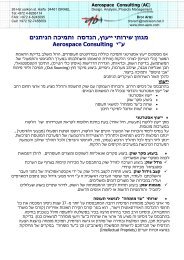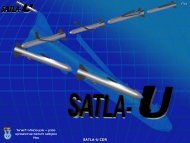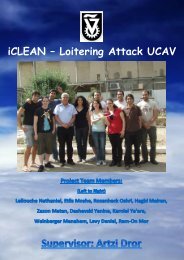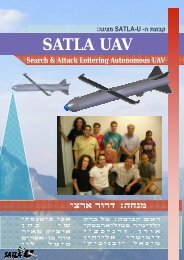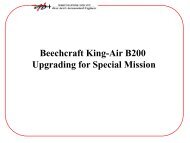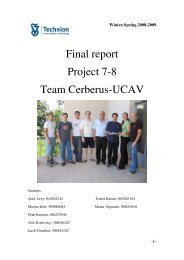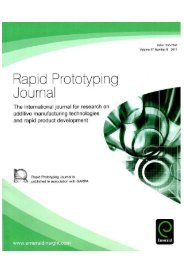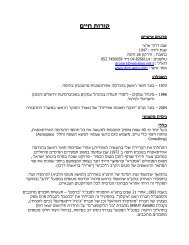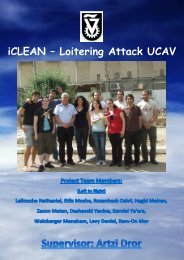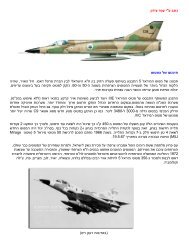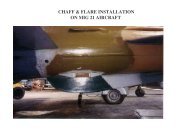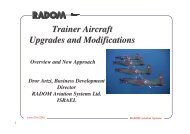Israel Aircraft Industries (IAI) Lavi - aero.com
Israel Aircraft Industries (IAI) Lavi - aero.com
Israel Aircraft Industries (IAI) Lavi - aero.com
Create successful ePaper yourself
Turn your PDF publications into a flip-book with our unique Google optimized e-Paper software.
Powerplant<br />
The powerplant of the <strong>Lavi</strong> was the Pratt & Whitney PW1120 turbofan, rated at 6,137 kg dry and<br />
9,337 kg with reheat and was a derivate of the F100 turbofan. The development of the PW1120,<br />
according to IDF/AF specifications, started in June 1980. It retained the F100 core module, gearbox,<br />
fuel pump, forward ducts, as well as the F100 digital electronic control, with only minor<br />
modifications. Unique PW1120 <strong>com</strong>ponents included a wide chord low pressure (LP) <strong>com</strong>pressor,<br />
single-stage uncooled low pressure (LP) turbine, simplified single stream augmentor, and a<br />
lightweight convergent/divergent nozzle. Full scale testing was initiated in June 1982, and flight<br />
clearance of the PW1120 was tested in August 1984. The PW1120 had 70 per cent similarity with the<br />
F100, so the IDF/AF would not need a special facility for spare parts. It would be built under licence<br />
by Bet-Shemesh Engines Limited in <strong>Israel</strong>.<br />
<strong>IAI</strong> installed one PW1120 in the starboard nacelle of an F-4E-32-MC of the IDF/AF (Number 334/66-<br />
0327) to explore the airframe/powerplant <strong>com</strong>bination for an upgrade program of the F-4E, known<br />
as Kurnass 2000 (Heavy Hammer) or Super Phantom and to act as an engine testbed for the <strong>Lavi</strong>.<br />
The powerplant was more powerful, and more fuel efficient than the General Electric J79-GE-17<br />
turbojet normally installed in the F-4E. The structural changes included modifying the air inlet ducts,<br />
new powerplant attachment points, new or modified powerplant baydoors, new airframe mounted<br />
gearbox with integrated drive generators and automatic throttle system. It also included a modified<br />
bleed management and air-conditioning ducting system, modified fuel and hydraulic systems, and a<br />
powerplant control/airframe interface. It was first flown on 30 July 1986. Two PW1120 powerplants<br />
were installed in the same F-4E and it was flown for the first time on 24 April 1987. This proved very<br />
successful, allowing the Kurnass 2000 to exceed Mach 1 without the afterburners, and endowing a<br />
<strong>com</strong>bat thrust-to-weight ratio of 1.04 (17 per cent better than the F-4E). This improved sustained<br />
turn rate by 15 per cent, climb rate by 36 per cent, medium-level acceleration by 27 per cent and lowlevel<br />
speed with 18 bombs from 1,046 km/h to 1,120 km/h. It was demonstrated at the Paris Air Show<br />
in 1987 carrying the show number 229 and civil registration 4X-JPA. However, McDonnell Douglas<br />
refused to approve the modification, because it offered a flight performance equal to that of the F/A-<br />
18C/D, and endangered any future sales of the F/A-18C/D.<br />
The internal fuel capacity was 3,330 liters (2,722 kg), some 16 per cent less than the F-16, although<br />
this was claimed to be offset by the low drag of the <strong>Lavi</strong> airframe and the low specific fuel<br />
consumption (sfc) of the powerplant. Single point high pressure refueling was adopted for quick<br />
turnaround, and provision made for air refueling with a female type receptacle <strong>com</strong>patible with<br />
flying boom-equipped tankers. To aid the flight test program, the <strong>Lavi</strong> prototypes were also equipped<br />
with bolt-on refueling probes. The external fuel capacity was 4,164 kg in two 2,548 liter drop tanks on<br />
the inboard pair wing stations.<br />
Specification of the Pratt & Whitney PW1120<br />
Performance ratings (ISA, S/L):<br />
Static thrust: 6,137 kg. Augmented thrust: 9,337 kg. Mass flow: 80.9 kg. Pressure ratio: 26.8.<br />
Specific fuel consumption:<br />
Static thrust: 22.7 mg/Ns. Augmentd thrust: 52.65 mg/Ns.<br />
Dimensions:<br />
Length: 4,110 mm. Maximum diameter: 1,021 mm.<br />
Weights:<br />
Dry weight: 1,292 kg.



